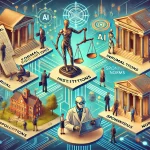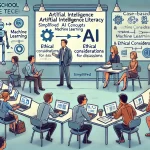
Elevate Biomedical Breakthroughs with ChatGPT’s AI Prowess
December 5, 20231.Introduction:
1.1 Overview of ChatGPT: AI’s Role in Biomedical Research
In recent years, the integration of artificial intelligence (AI) into various domains has led to groundbreaking advancements, and one of the most promising areas of application is biomedical research. ChatGPT, developed by OpenAI, stands out as a powerful language model that has demonstrated remarkable capabilities in natural language understanding and generation. This paper explores the potential of ChatGPT in revolutionizing the landscape of biomedical research.
Biomedical research is a complex and dynamic field that involves the study of biological systems, diseases, and the development of innovative medical solutions. Traditionally, researchers have relied on experimental methods and manual literature reviews to gather information. However, the increasing volume of biomedical data and the need for rapid information processing have created a demand for sophisticated AI tools.
ChatGPT, based on the GPT-3.5 architecture, excels in understanding and generating human-like text. Its ability to comprehend context, extract relevant information, and generate coherent responses makes it a valuable asset in the biomedical research domain. This paper delves into the specific applications of ChatGPT in tasks such as literature review, data analysis, and knowledge synthesis within the context of biomedical research.
1.2 Unleashing Transformation: ChatGPT’s Potential in Biomedicine
The transformative potential of ChatGPT in biomedicine is multifaceted. One of its primary contributions lies in the acceleration of literature review processes. ChatGPT can analyze vast amounts of biomedical literature, extracting key insights and summarizing complex information in a comprehensible manner. This not only saves researchers time but also enables them to stay updated on the latest advancements in their respective fields.
Furthermore, ChatGPT facilitates collaboration and knowledge sharing among researchers. Its natural language generation capabilities empower it to communicate effectively, aiding in the creation of collaborative platforms where researchers can discuss findings, share ideas, and collectively address challenges. This collaborative aspect fosters a more interconnected and dynamic research community.
In addition to literature review and collaboration, ChatGPT proves instrumental in data analysis. Biomedical research often involves handling large datasets, and ChatGPT can assist in extracting meaningful patterns, identifying correlations, and generating hypotheses. By automating certain aspects of data analysis, researchers can focus on the interpretation of results and the formulation of experimental designs.
The paper also explores the ethical considerations and challenges associated with the integration of ChatGPT in biomedical research. Issues such as bias in language models, data privacy concerns, and the responsible use of AI are crucial aspects that need careful consideration. Understanding and addressing these challenges is essential for ensuring the responsible and ethical deployment of ChatGPT in the field of biomedicine.
In summary, this paper aims to provide a comprehensive overview of ChatGPT’s role in biomedical research, emphasizing its potential to transform the way researchers gather information, collaborate, and analyze data. Through a detailed exploration of applications, benefits, and ethical considerations, we aim to contribute to the ongoing discourse on the responsible integration of AI in the pursuit of advancements in biomedicine.
2.ChatGPT in Bioinformatics:
2.1 Unraveling Mysteries: Large-Scale Data Analysis with ChatGPT
Bioinformatics is a field that deals with the application of computational techniques to analyze and interpret biological data. One of the significant challenges in bioinformatics is handling large-scale datasets generated from various biological experiments. ChatGPT plays a crucial role in unraveling these mysteries by providing a powerful tool for large-scale data analysis.
The language model’s ability to understand and generate human-like text allows it to process vast amounts of textual data, including research papers, experiment results, and annotated datasets. ChatGPT can assist bioinformaticians in conducting comprehensive literature reviews, extracting relevant information, and summarizing key findings. By automating the initial stages of data analysis, researchers can efficiently identify patterns, trends, and potential correlations within the vast sea of biological information.
Moreover, ChatGPT can be employed to interactively query databases, helping researchers formulate complex queries in natural language and obtain meaningful results. This interaction simplifies the process of exploring and extracting valuable insights from extensive biological databases, ultimately contributing to a more streamlined and efficient research workflow.
2.2 Algorithmic Advancements: Pattern Recognition and Classification
Pattern recognition and classification are fundamental aspects of bioinformatics, especially in tasks such as gene expression analysis, protein structure prediction, and disease classification. ChatGPT’s algorithmic advancements come into play in enhancing these processes. The language model can be fine-tuned to recognize patterns within biological data, aiding in the development of more accurate predictive models.
By training ChatGPT on labeled datasets, researchers can harness its pattern recognition capabilities to identify subtle and complex relationships within biological information. This can lead to improvements in the accuracy of predictive algorithms, enabling more precise predictions in areas such as identifying potential drug candidates, understanding the genetic basis of diseases, and predicting patient outcomes.
The fine-tuning process also allows researchers to customize ChatGPT for specific bioinformatics tasks, tailoring its capabilities to the unique challenges presented by different types of biological data. This adaptability makes ChatGPT a versatile tool for bioinformaticians seeking to optimize their algorithms for various applications in the field.
2.3 Deeper Insights: Data Visualization and Analysis Tools
While text-based data analysis is a strength of ChatGPT, its integration with data visualization and analysis tools adds another layer of depth to bioinformatics research. The language model can assist in generating natural language descriptions of visualizations, making complex graphical representations more accessible to researchers without extensive expertise in data interpretation.
By incorporating ChatGPT into data visualization tools, bioinformaticians can benefit from interactive and dynamic analyses. The model can interpret visual patterns, provide context to plotted data points, and generate hypotheses based on observed trends. This synergy between ChatGPT and visualization tools empowers researchers to derive deeper insights from their data, leading to more informed decision-making in the exploration of biological phenomena.
In conclusion, ChatGPT’s applications in bioinformatics extend from large-scale data analysis to algorithmic advancements and interactive data visualization. Its unique combination of language understanding and generation capabilities positions it as a valuable asset in the quest to unravel biological mysteries and advance our understanding of the intricate complexities within the field of bioinformatics.
3.ChatGPT in Computational Biology:
3.1 Modeling Precision Medicine: ChatGPT’s Role in Biological Systems
Precision medicine aims to tailor medical treatment and interventions to individual characteristics, considering factors such as genetics, lifestyle, and environment. ChatGPT’s role in precision medicine within the realm of computational biology involves modeling biological systems at a level of detail that allows for personalized predictions and interventions.
ChatGPT can be utilized to integrate vast amounts of heterogeneous data, including genomic information, patient records, and environmental factors. By understanding and generating human-like text, ChatGPT can assist in the creation of comprehensive models that simulate the behavior of biological systems. This modeling approach enables researchers and healthcare practitioners to predict individual responses to treatments, identify potential risks, and optimize therapeutic strategies for precision medicine applications.
The language model’s ability to comprehend complex biological relationships and generate coherent responses contributes to the development of sophisticated computational models that account for the intricacies of individual patient profiles. As a result, ChatGPT becomes an invaluable tool in the pursuit of more personalized and effective healthcare interventions.
3.2 Functional Insights: Simulating Biological Processes
Computational biology involves simulating and modeling biological processes to gain insights into the functioning of living organisms. ChatGPT can play a crucial role in generating descriptions, hypotheses, and interpretations of simulated biological processes. This capability facilitates communication between researchers and computational models, enhancing the understanding of complex biological phenomena.
By integrating ChatGPT with computational models, researchers can interactively explore and refine simulations. The language model can assist in formulating queries, interpreting simulation outputs, and generating hypotheses based on the simulated results. This collaborative interaction between researchers and computational models accelerates the discovery process and fosters a deeper understanding of the functional aspects of biological systems.
Moreover, ChatGPT’s natural language generation capabilities contribute to the documentation and communication of simulation results. Researchers can use the language model to automatically generate detailed reports, making it easier to disseminate findings, share insights, and collaborate with peers in the computational biology community.
3.3 Guiding Drug Discovery: Therapy Development with Computational Models
The process of drug discovery involves the identification of potential therapeutic targets, the design of drug molecules, and the assessment of their efficacy. ChatGPT can guide drug discovery efforts by assisting in the analysis of biological data, predicting potential drug-target interactions, and generating hypotheses for experimental validation.
In drug development, ChatGPT can contribute to the identification of novel targets by analyzing complex biological networks and suggesting potential candidates based on known associations and interactions. Furthermore, the language model’s ability to understand and generate text allows it to provide explanations and justifications for proposed drug-target interactions, aiding researchers in the decision-making process.
By integrating ChatGPT into computational models used in drug discovery, researchers can streamline the exploration of chemical spaces, predict drug properties, and optimize lead compounds. The collaborative synergy between human researchers and AI-driven models enhances the efficiency of drug discovery pipelines, potentially accelerating the development of new therapeutic interventions.
In conclusion, ChatGPT’s applications in computational biology span from modeling precision medicine to providing functional insights and guiding drug discovery. Its unique combination of language understanding and generation capabilities positions it as a valuable tool for researchers seeking to leverage computational approaches to unravel the complexities of biological systems and advance the field of computational biology.
4.ChatGPT in Health Informatics:
4.1 Extracting Wisdom: AI and Electronic Health Records for Disease Surveillance
Health informatics involves the application of information technology to the field of healthcare, and electronic health records (EHRs) play a central role in this domain. ChatGPT can contribute significantly to health informatics by extracting wisdom from vast amounts of patient data stored in EHRs, particularly in the context of disease surveillance.
With its natural language processing capabilities, ChatGPT can sift through textual data within EHRs, identifying relevant information related to disease symptoms, patient histories, and treatment outcomes. By analyzing patterns and trends in this data, ChatGPT can aid in early detection of disease outbreaks, tracking the spread of infectious diseases, and providing valuable insights for public health surveillance.
The language model’s ability to generate coherent responses further facilitates communication between healthcare professionals and the information embedded in EHRs. This collaborative approach enhances the efficiency of disease surveillance efforts, allowing for more proactive and informed decision-making to address public health challenges.
4.2 AI-Powered Decision-Making: Enhancing Clinical Support Systems
In the realm of health informatics, ChatGPT can play a pivotal role in enhancing clinical decision support systems (CDSS). These systems assist healthcare professionals by providing evidence-based recommendations, interpreting diagnostic results, and offering treatment suggestions. ChatGPT’s contribution lies in its ability to understand and generate human-like text, enabling more natural and interactive communication within CDSS.
Healthcare providers can interact with ChatGPT to seek explanations for diagnostic results, inquire about potential treatment options, and receive relevant information tailored to specific patient cases. The language model’s natural language generation capabilities help bridge the gap between the complex output of machine learning algorithms and the understanding of healthcare professionals, fostering a collaborative decision-making environment.
Additionally, ChatGPT can contribute to the continuous learning and improvement of CDSS by analyzing feedback from healthcare professionals. Through iterative interactions, the model can adapt to evolving medical knowledge, stay updated on the latest research findings, and enhance its ability to provide accurate and contextually relevant information for clinical decision-making.
4.3 Personalized Healthcare: Tailored Solutions through AI
Personalized healthcare involves tailoring medical interventions to individual characteristics, preferences, and needs. ChatGPT contributes to personalized healthcare within the field of health informatics by facilitating natural language interactions to understand and address individual patient concerns.
The language model can assist in the development of personalized health plans by analyzing patient data, including medical history, genetic information, and lifestyle factors. ChatGPT’s natural language understanding allows it to engage in conversations with patients, helping them understand their health conditions, providing information about treatment options, and offering guidance on lifestyle modifications.
Moreover, ChatGPT can support healthcare providers in delivering personalized health education materials. By generating clear and concise explanations tailored to individual patient profiles, the language model enhances patient understanding and engagement, ultimately leading to more effective self-management of health conditions.
In summary, ChatGPT’s applications in health informatics encompass extracting wisdom from EHRs for disease surveillance, enhancing clinical decision support systems through AI-powered decision-making, and contributing to the realization of personalized healthcare by providing tailored solutions through natural language interactions. The integration of ChatGPT in health informatics holds the potential to improve the efficiency, accuracy, and personalization of healthcare delivery.
5.ChatGPT in Omics:
5.1 Unlocking Biomarkers: Omics Data Analysis with ChatGPT
Omics, a term that encompasses genomics, proteomics, metabolomics, and other high-throughput biological data analysis, generates vast amounts of complex information. ChatGPT’s role in omics lies in unlocking biomarkers—identifiable characteristics that can indicate the presence or progression of a disease. ChatGPT can aid researchers in the analysis of omics data to identify and understand potential biomarkers.
By leveraging its natural language processing capabilities, ChatGPT can interpret and extract meaningful patterns from omics datasets, facilitating the identification of candidate biomarkers. The language model can engage in interactive discussions with researchers, assisting in the formulation of hypotheses, the interpretation of results, and the exploration of potential associations within the complex omics landscape.
The ability of ChatGPT to generate human-like text is particularly valuable in conveying insights from omics data analysis. Researchers can use the language model to communicate findings, generate reports, and collaborate with peers, ultimately contributing to the advancement of biomarker discovery in various fields, such as oncology, cardiovascular research, and personalized medicine.
5.2 Diagnostics Revolution: Omics-Driven Insights in Therapeutics
Omics data has revolutionized diagnostics and personalized therapeutics, offering insights into individual variations in genes, proteins, and metabolites. ChatGPT plays a significant role in this diagnostic revolution by assisting in the interpretation of omics-driven insights and facilitating the translation of these insights into therapeutic strategies.
In diagnostics, ChatGPT can help healthcare professionals understand and communicate the implications of omics data for patient health. The language model can generate clear and comprehensible explanations of complex genomic or proteomic information, aiding in the diagnosis of diseases with a genetic component or those characterized by specific molecular signatures.
Furthermore, ChatGPT can contribute to the development of personalized therapeutic approaches based on omics data. By analyzing individual patient profiles, the language model can assist in formulating treatment plans, predicting potential drug responses, and optimizing therapeutic interventions. This personalized approach to therapeutics represents a paradigm shift in healthcare, and ChatGPT serves as a facilitator in translating omics-driven insights into actionable and patient-specific treatment strategies.
5.3 Deciphering Complexity: Genes, Proteins, and Metabolites Interplay
The interplay between genes, proteins, and metabolites is central to understanding the complexity of biological systems. ChatGPT aids in deciphering this complexity by facilitating natural language interactions that allow researchers to explore and discuss the intricate relationships between these molecular components.
Through interactive discussions, researchers can use ChatGPT to explore hypotheses about how genetic variations may impact protein expression or how changes in metabolite levels may influence cellular processes. The language model’s ability to understand context and generate relevant responses enhances the collaborative exploration of the complex interactions within biological systems.
Additionally, ChatGPT can assist in literature review processes related to the integration of omics data. By summarizing and contextualizing information from scientific literature, the language model helps researchers stay informed about the latest discoveries and advancements in the field of genomics, proteomics, and metabolomics.
In conclusion, ChatGPT’s applications in omics span from unlocking biomarkers through data analysis to contributing to the diagnostics revolution and deciphering the intricate interplay of genes, proteins, and metabolites. Its natural language understanding and generation capabilities make it a valuable tool for researchers and healthcare professionals seeking to navigate and harness the wealth of information generated by omics technologies.
6.ChatGPT in Data Science:
6.1 Biomedical Data Preparation: ChatGPT’s Role in Cleaning and Preparing Data
Data preparation is a critical step in the data science pipeline, and in the biomedical field, where datasets can be large and complex, ChatGPT plays a valuable role in cleaning and preparing data. The language model’s natural language processing capabilities enable it to understand and generate text, making it adept at assisting data scientists in tasks such as data cleaning, normalization, and imputation.
ChatGPT can be employed to interactively guide researchers through the process of cleaning and preparing biomedical data. It can assist in identifying and handling missing values, detecting outliers, and standardizing formats. By engaging in a natural language conversation, researchers can efficiently communicate data cleaning requirements, and ChatGPT can provide suggestions and generate code snippets to automate parts of the cleaning process.
Moreover, the language model can contribute to documentation efforts by generating descriptions of the data cleaning steps undertaken. This not only helps in maintaining a comprehensive record of data preparation processes but also facilitates knowledge sharing and collaboration among data science teams working on biomedical projects.
6.2 Machine Learning Applications: Enhancing Biomedical Data Analysis
Machine learning applications are central to biomedical data analysis, ranging from predictive modeling to pattern recognition. ChatGPT enhances the capabilities of data scientists by assisting in the application of machine learning algorithms to biomedical datasets.
ChatGPT can be used to generate code snippets for common machine learning tasks, such as feature selection, model training, and evaluation. Its natural language understanding allows it to interpret user queries and provide relevant examples or explanations of machine learning concepts, aiding researchers in selecting appropriate algorithms and fine-tuning model parameters.
Additionally, ChatGPT can assist in the interpretation of machine learning model outputs. By generating explanations in natural language, the language model helps data scientists understand the factors contributing to model predictions, facilitating the identification of key features and insights derived from the biomedical data.
6.3 Actionable Insights: Visualizing and Interpreting Data Findings
Data visualization is a crucial component of data science that helps communicate complex findings in a comprehensible manner. ChatGPT contributes to this aspect by assisting in the generation of visualizations and providing interpretations of data findings.
Researchers can interactively communicate with ChatGPT to explore different visualization techniques, ask for recommendations on the most suitable visualization for specific types of biomedical data, and seek insights into the patterns and trends observed in the visualized data. The language model’s ability to generate coherent responses makes it a valuable companion in the process of translating data into actionable insights.
Furthermore, ChatGPT can assist in generating narrative reports that accompany data visualizations. By providing natural language descriptions of the visualized findings, the language model supports researchers in preparing reports, presentations, and publications, ensuring that the insights derived from biomedical data are effectively communicated to diverse audiences.
In summary, ChatGPT’s applications in data science within the biomedical domain extend from data preparation and machine learning applications to generating actionable insights through data visualization and interpretation. Its natural language understanding and generation capabilities make it a versatile tool for enhancing the efficiency and effectiveness of data science workflows in biomedical research.
7.The Future of ChatGPT in Biomedicine:
7.1 Continuous Development: ChatGPT’s Ongoing Refinement for Enhanced Capabilities
The future of ChatGPT in biomedicine is marked by a commitment to continuous development and refinement. As technology evolves and new challenges emerge in the biomedical field, there is a need for ChatGPT to undergo iterative improvements. Ongoing research and development efforts will focus on enhancing the language model’s understanding of complex biomedical concepts, improving its ability to handle domain-specific terminology, and refining its natural language generation capabilities.
Updates to ChatGPT may include domain-specific training on the latest biomedical literature, ensuring that the model remains up-to-date with the rapidly advancing knowledge in fields such as genomics, proteomics, and pharmacology. Additionally, efforts may be directed towards addressing ethical considerations, bias reduction, and ensuring the responsible deployment of ChatGPT in biomedical research and healthcare settings.
By incorporating user feedback, collaborating with domain experts, and staying abreast of advancements in biomedical sciences, ChatGPT will evolve into a more reliable and sophisticated tool for researchers, clinicians, and other professionals working in the biomedicine domain.
7.2 Expanding Applications: ChatGPT’s Reach Across Diverse Biomedical Fields
The future holds vast potential for the expansion of ChatGPT’s applications across diverse biomedical fields. Currently applied in areas such as data analysis, literature review, and decision support, ChatGPT is poised to explore new frontiers within biomedicine. Its natural language understanding and generation capabilities make it adaptable to various tasks, ranging from drug discovery and personalized medicine to patient engagement and healthcare communication.
As researchers and practitioners become more familiar with ChatGPT’s capabilities, there is the prospect of incorporating the model into novel applications. For instance, ChatGPT could be integrated into virtual laboratories, aiding scientists in experimental design, protocol development, and data interpretation. Similarly, the language model may find applications in patient education, providing easily understandable information about medical conditions, treatment options, and lifestyle modifications.
By expanding the range of applications, ChatGPT has the potential to become an indispensable tool across the entire spectrum of biomedical research and healthcare, contributing to increased efficiency, collaboration, and innovation.
7.3 Catalyst for Innovation: ChatGPT Driving Progress in Biomedicine
ChatGPT is positioned to be a catalyst for innovation in biomedicine, driving progress in research, diagnostics, and therapeutic development. Its unique combination of language understanding and generation capabilities makes it a versatile tool for fostering creativity, collaboration, and exploration of new ideas within the biomedical community.
Innovations may emerge as researchers leverage ChatGPT’s conversational abilities to brainstorm ideas, validate hypotheses, and share insights with peers. The model’s capacity to handle complex biomedical information and generate coherent responses can accelerate the pace of discovery, enabling researchers to focus on the conceptualization and design of groundbreaking experiments and studies.
Moreover, ChatGPT’s integration with other advanced technologies, such as machine learning models and data visualization tools, could lead to synergistic advancements. The model may become an integral component of interdisciplinary research teams, facilitating communication and collaboration between researchers with diverse expertise in biology, data science, and clinical medicine.
In conclusion, the future of ChatGPT in biomedicine is characterized by continuous development, expanding applications across diverse fields, and serving as a catalyst for innovation. As the model evolves and its capabilities are further harnessed, ChatGPT is poised to contribute significantly to the transformative advancements in biomedical research and healthcare, shaping the landscape of innovation in the years to come.

















